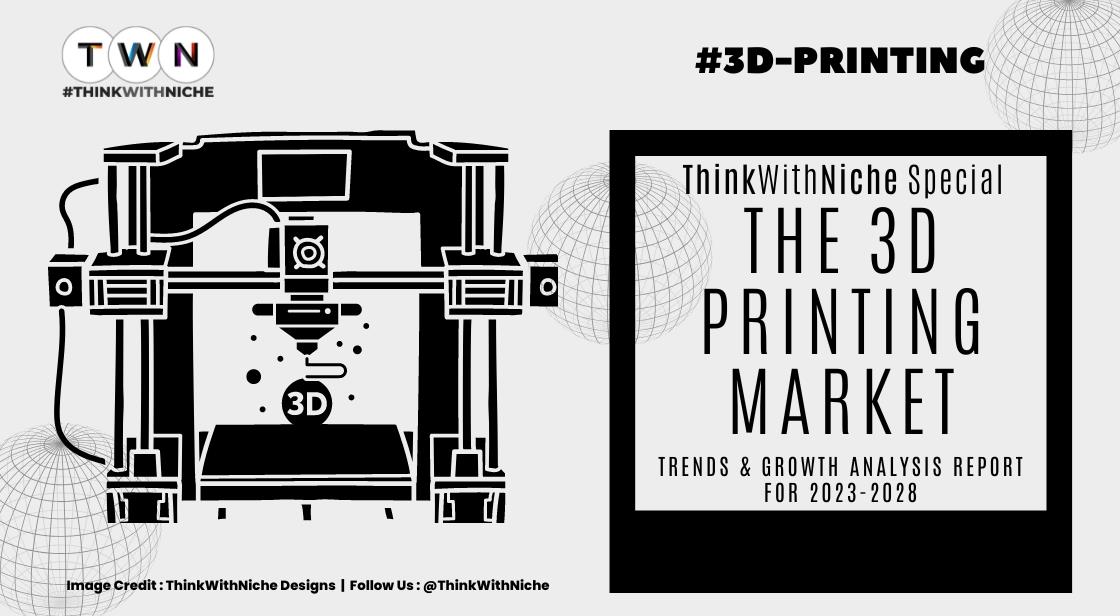The 3D Printing Market: Trends and Growth Analysis Report for 2023-2028

Blog Post
3D printing is a rapidly growing technology that has the potential to revolutionize the manufacturing industry. With its ability to produce customized products quickly and efficiently, 3D printing is changing the way businesses think about product design and development.
The market for 3D printing is projected to reach USD 15.0 billion in 2023 and USD 34.5 billion by 2028, at a CAGR of 18.1%. This significant growth is being driven by several key factors, including the ease of developing customized products, reductions in manufacturing costs and process downtime, government investments in 3D printing projects, and the development of new industrial-grade 3D printing materials.
The scope of development and growth in the 3D printing industry is vast, with applications in a variety of industries, from healthcare and aerospace to consumer products and jewelry. Technology has already made significant advancements, including the development of new materials, software, and printing techniques. As businesses and governments continue to invest in technology, the possibilities for 3D printing are virtually limitless. The future of the 3D printing market is bright, with a focus on industrial-grade printing and the development of new materials and applications.
As technology becomes more accessible and affordable, we can expect to see a rise in customized products and innovative designs. The 3D printing market is poised for continued growth in the coming years, and businesses that invest in this technology now will be well-positioned to succeed in the future.
The Growth of the 3D Printing Market and Key Factors Contributing to its Success
The 3D printing market has seen significant growth in recent years, with a projected market size of USD 15.0 billion in 2023 and USD 34.5 billion by 2028, at a CAGR of 18.1%. One of the key factors contributing to this growth is the ease of developing customized products using 3D printers. With 3D printing technology, businesses can design and manufacture products that are tailored to the specific needs of their customers, allowing for greater flexibility and innovation. Additionally, 3D printing can significantly reduce manufacturing costs and process downtime, making it an attractive option for businesses of all sizes.
Another key factor driving the growth of 3D printing is government investment in 3D printing projects. Governments around the world have recognized the potential of 3D printing technology and have invested in research and development to advance the field. For example, the European Space Agency recently developed an X-Ray telescope using plasma metal deposition and 3D printing, highlighting the versatility and potential of this technology.
Top International Players in the 3D Printing Industry
-
Stratasys (US): Stratasys is a leading provider of FDM-based 3D printing systems and services. Their products are used in a variety of industries, including aerospace and defense, automotive, and healthcare.
-
Ultimaker (Netherlands): Ultimaker is a Dutch 3D printing company that offers a range of desktop and industrial-grade 3D printers, as well as software and materials. Their products are used in industries such as architecture, engineering, and product design.
-
Afinia 3D (US): Afinia 3D is a US-based company that provides affordable and easy-to-use desktop 3D printers. Their products are used in a variety of applications, from education to product design.
-
Intuitive Surgical (US): Intuitive Surgical is a US-based medical technology company that specializes in robotic-assisted surgery. They use 3D printing to create custom surgical instruments and implants.
-
Samsung Electronics (South Korea): Samsung Electronics is a South Korean electronics company that has recently entered the 3D printing market. They are currently developing a range of consumer-focused 3D printers and software.
The Future of the 3D Printing Market
The 3D printing market is expected to continue its growth trajectory in the coming years, with a focus on industrial-grade 3D printing and the development of new materials. In particular, the consumer products vertical is expected to see significant growth, driven by the adoption of low-cost desktop 3D printers and the rise of start-up companies offering customized functional products.
Europe is projected to hold a significant share of the 3D printing market during the forecast period. This is due to technological advancements, increased availability of various raw materials, regulatory policies, government support, low financial requirements, and the ability to facilitate fast and accurate product development in the region. Germany and the UK are two major countries contributing to the 3D printing market in Europe.
In addition to Europe, the Asia Pacific region is also expected to see significant growth in the 3D printing market, driven by the rise of industrial and manufacturing industries in countries like China and India. The North American region is also expected to continue to hold a significant share of the market, thanks to the region's strong presence in the aerospace and defense industries.
Below are the key findings for our readers to know more about 3D printing and its ecosystem build-up for the future of this industry.
Understanding 3D Printing Technology
3D printing, also known as additive manufacturing, is a process of creating three-dimensional objects from a digital design. Unlike traditional manufacturing processes, which involve cutting and shaping materials to create a final product, 3D printing builds objects layer by layer using a variety of materials such as plastics, metals, and even food.
-
How is 3D Printing Different from Generic Printing?
While traditional printing involves creating two-dimensional images on paper or other materials, 3D printing creates three-dimensional objects by layering materials on top of each other. The process is much more complex than traditional printing and requires specialized equipment and software.
-
Types of 3D Printing and Their Purpose
There are several types of 3D printing, including FDM, SLA, SLS, and DMLS, each with a unique purpose. FDM, or fused deposition modelling, is the most commonly used type of 3D printing and is used to create prototypes, concept models, and functional parts. SLA, or stereolithography, is used to create high-detail, accurate parts, while SLS, or selective laser sintering, is used to create parts with complex geometries. DMLS, or direct metal laser sintering, is used to create parts from metal alloys.
-
Is 3D Printing a Complex Process?
While 3D printing may seem complex, the process is relatively simple once you understand the basics. It involves creating a 3D model using specialized software, which is then sent to a 3D printer that builds the object layer by layer.
-
Cost-Effectiveness of 3D Printing
While 3D printing equipment and materials can be expensive, the technology can be cost-effective in the long run, especially for businesses that require customized or low-volume production. By reducing the need for traditional manufacturing processes and tooling, 3D printing can significantly reduce production costs.
Also Read: Automation Fashion Industries 4 Challenges
-
Types of 3D Printing Equipment
There are several types of 3D printing equipment, including desktop printers, industrial-grade printers, and hybrid printers that combine multiple printing technologies. Desktop printers are the most affordable and are suitable for low-volume production and prototyping, while industrial-grade printers are more expensive and are used for high-volume production and professional applications. Hybrid printers offer the best of both worlds and can be used for a variety of applications.
ThinkWithNiche's Last Words: Overall, the 3D printing market is poised for continued growth in the coming years, as businesses and governments alike recognize the potential of this technology to revolutionize manufacturing and product development. As new materials, technologies, and applications are developed, the possibilities for 3D printing are virtually limitless.
You May Like
EDITOR’S CHOICE












